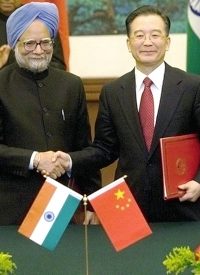
The civilizations of China and India are two of the oldest in human history. Archeologists have found Bronze Age Indian artifacts from about 3,300 B.C. in the Indus River Valley, and say that signs of human activity in India date back many thousand years before that. China is relatively younger, with the earliest signs of civilization about 4,000 years ago, and signs of human life many thousand years before that.
Two of the four cradles of civilization have long been believed to be India’s Indus River Valley and China’s Yangtze River Valley. Very early sophistication in writing, architecture, metaphysical systems, and technology endowed these lands with wealth and culture.
The governments which have arisen out of the two ancient civilizations of China and India have generally been nonaggressive. Alexander the Great’s Macedonians attempted to invade the Hindu Kush, not the reverse. The Great Khan overran the Chin Kingdom, not vice versa. Perhaps the salient characteristic of these very old lands, however, has been the lack of dynamism. China, about the time of Columbus, already possessed the technology and wealth to find the Western Hemisphere and provide land for its teeming peasant populations; instead, it chose to deliberately withdraw into itself. The Chinese equivalent of the State Department or Foreign Ministry was the “Department of Barbarian Affairs.”
India, fabulously rich and populous, was easy prey to British, French, Portuguese, and Dutch occupation because of a sort of apathy about life which bordered on indifference.
Part of the reason for both China’s and India’s disdain for the outside world was the great complexity and size of the two countries. Why should Chinese or Indians care about the rest of the world, when each realm was so huge and diverse that the average inhabitant could never begin to absorb even what lay within the borders of each empire? Part of the reason, however, for their insular behavior was that both of these civilizations were married to metaphysical systems which found no merit in growth, or pioneering or hope.
Hinduism — or Brahmanism, as India’s “Untouchables” call it — is an utterly static view of life. One is born into a caste, and may not rise or fall from that caste in his lifetime. Human suffering is always believed to be deserved because of one’s sins in a prior life. According to National Geographic, Untouchables are “tainted by their birth into a caste system that deems them impure, less than human.” Further, academics in Hindu India have always involved the study of old texts, which though beautiful and thoughtful, provide no hope of understanding the world.
When the West came into direct contact with India, those few who adopted a view of life which embraced a divine Creator, such as the Parsees (or Zoroastrians) of Bombay, were incredibly overrepresented in science, art, industry, and charity. When India was occupied by Muslim overlords, many Hindus converted to Islam, largely to escape the atheistic and fundamentally hopeless cycle of reincarnation, which ended only when a soul reached “Nirvana” or oblivion.
China also saw mankind as rigidly divided into a sort of caste system, and viewed all outsiders as fundamentally different and inferior. The famous Confucian System — not a religion but rather a code of moral conduct — is admirable in many ways. For instance, Confucianism honors parents, promotes peace, encourages industry, and considers justice a virtue. However, like Hinduism, Confucianism and the other indigenous Chinese metaphysical systems are static. And this attitude carries over to politics and government.
The historical boundaries of India and of China, therefore, cannot be changed. When the flow of history has compelled these two countries to adopt political change, the results have been horrific. Why? Like an earthquake produced by the long-building tension of continental plates which have not moved, change in both China and India is a sudden shock to the systems of those nations.
For instance, Westerners warned that the end of British rule in India would lead to an orgy of blood and mayhem — and it did. Millions of Muslims and Hindus killed and were killed. Though the Untouchables begged the British to stay, the pious words of Indian nationalists (nearly all Brahmins themselves) overawed public opinion in Britain.
In 1949, the defeat of Chiang Kai-shek’s Party of the People (Kuomintang) by Mao’s Chinese Communists led to the beginning of genocide in Tibet and was also the prelude to Mao’s Great Leap Forward — a preventable calamity predicted by anti-Communists and ignored except by all except them.
Today, India and China are fighting along perhaps the oldest border in the history of the world. The “Line of Actual Control” has become a diplomatic term for territories occupied by each nation, whether the other country concedes the propriety of that occupation or not. The governments of both China and India have tended to downplay these battles. The Indian Foreign Minister, for instance, has stated: “It will be recollected that there are differences in perception between India and China on the Line of Actual Control in this area,” and the Chinese Foreign Ministry has responded: “Chinese border personnel have respected the two agreements between the two countries on maintaining peace and tranquility in the border area, and have never crossed the Line of Actual Control.”
What makes these border disputes ironic in Western eyes is that most of these territories are inhabited by Tibetans, Sikhs, and other peoples who do not consider themselves Chinese or Indian — and regions such as Kashmir and Sikkim, which either have claimed independence for themselves or are territories disputed with other nations such as Pakistan.
Though ultra-modern in some respects, both India and China seem in other ways not to have changed at all in 3,000 years. Confucianism in China has been replaced by Communism, which is also very inflexible. Brahmanism in India has been replaced somewhat by the socialism so attractive to the Nehru family dynasty. These influences, however, offer no hope of change. These variations of Marxism are presumed to be iron laws of human behavior, and no matter what the calamity caused by socialist principles in operation, the basic premises are always deemed still valid.
On the other hand, Christianity historically has been the great catalyst for change in human thinking. Both Doctor Sun Yat-Sen and General Chiang Kai-shek, the first two political leaders of the Republic of China, were Christians — a remarkable historical fact which seldom receives the attention it deserves. The Republic of China on Taiwan became an economic powerhouse while the wretches of Mao’s China starved by the millions. Mother Teresa, an Albanian nun who became so beloved for her Christian compassion that she received one of the two state funerals in India’s history (Gandhi was the other), demonstrated how the Christian ideals could defang the caste system.
Christianity is now under severe attack in both India and China. The resentment in India comes from Hindus, who engage in horrific crimes, and whose objection to Christianity dates back to the first decades of the last century, when Christians allow Untouchables to become full and practicing members of any congregation. The persecution of Christians in China is based upon the fear that the Communist bosses of China would find in a Christian population the same sort of obstacle that the Soviets found in Catholic Poland: peaceful, but quiet, conquest of the Chinese soul.
Until the philosophical underpinnings of these two great nations change, one can expect continued persecution at home and border wars with neighbors.
Photo: Indian Prime Minister Manmohan Singh with Chinese Premier Wen Jiabao at the Great Hall of the People in Beijing



